Analysis on the Influence of Incident Light Angle on the Spatial Aberrations of Acousto-Optical Tunable Filter Imaging
Abstract
:1. Introduction
2. Method
2.1. Ray Tracing of Arbitrary Light in Three-Dimensional Space
2.2. Aberration Simulation of AOTF at Different Incident Angles
3. Results
3.1. Experiment of the Aberration Distribution Characteristics with Integrating Sphere as the Target
3.2. Quantitative Experiment with the Square Grid as the Target
4. Conclusions and Future Directions
Author Contributions
Funding
Institutional Review Board Statement
Informed Consent Statement
Data Availability Statement
Acknowledgments
Conflicts of Interest
References
- Machikhin, A.S.; Zinin, P.V.; Shurygin, A.V. Imaging system based on a tandem acousto-optical tunable filter for In Situ measurements of the high temperature distribution. Opt. Lett. 2016, 41, 901–904. [Google Scholar] [CrossRef] [PubMed]
- Scharf, V. Four-band fiber optic radiometry for true temperature measurements during an exothermal process. Opt. Eng. 2002, 41, 1502–1506. [Google Scholar] [CrossRef]
- Campbell, A.J. Measurement of temperature distributions across laser heated samples by multispectral imaging radiometry. Rev. Sci. Instrum. 2008, 79, 21731. [Google Scholar] [CrossRef] [Green Version]
- Zhao, H.; Wang, Z.; Jia, G. Chromatic aberrations correction for imaging spectrometer based on acousto-optic tunable filter with two transducers. Opt. Express 2017, 25, 23809–23825. [Google Scholar] [CrossRef] [PubMed]
- Yushkov, K.B.; Molchanov, V.Y.; Ovchinnikov, A.V.; Chefonov, O.V. Acousto-optic replication of ultrashort laser pulses. Phys. Rev. A 2017, 96, 043866. [Google Scholar] [CrossRef]
- Molchanov, V.Y.; Yushkov, K.B.; Kostryukov, P.V. Measurement of amplified binary-modulated chirped laser pulses generated by different acousto-optic pulse shaping algorithms. Opt. Laser Technol. 2021, 142, 107220. [Google Scholar] [CrossRef]
- Zhang, C.; Wang, H.; Huang, J. The visible to the near infrared narrow band acousto-optic tunable filter and the hyperspectral microscopic imaging on biomedicine study. J. Opt. 2014, 16, 125303. [Google Scholar] [CrossRef]
- Yushkov, K.B.; Molchanov, V.Y.; Belousov, P.V. Contrast enhancement in microscopy of human thyroid tumors by means of acousto-optic adaptive spatial filtering. J. Biomed. Opt. 2016, 21, 016003. [Google Scholar] [CrossRef] [PubMed] [Green Version]
- Yushkov, K.B.; Molchanov, V.Y. Acousto-optic filters with arbitrary spectral transmission. Opt. Commun. 2015, 355, 177–180. [Google Scholar] [CrossRef]
- Gupta, N.; Voloshinov, V.B. Hyperspectral imaging performance of a TeO2 acousto-optic tunable filter in the ultraviolet region. Opt. Lett. 2005, 30, 985–987. [Google Scholar] [CrossRef] [PubMed]
- Gupta, N.; Suhre, D.R. Notch filtering using a multiple passband AOTF in the SWIR region. Appl. Opt. 2016, 55, 7855–7860. [Google Scholar] [CrossRef] [PubMed]
- Chanover, N.J.; Glenar, D.A.; Voelz, D.G.; Xiao, X.; Tawalbeh, R.; Boston, P.J.; Brinckerhoff, W.B.; Mahaffy, P.R.; Getty, S. An AOTF-LDTOF spectrometer suite for In Situ organic detection and characterization. In Proceedings of the IEEE Aerospace Conference, Big Sky, MT, USA, 5–12 March 2011. [Google Scholar]
- Glenar, D.A.; Hillman, J.J.; Saif, B.; Bergstralh, J. Acousto-optic imaging spectropolarimetry for remote sensing. Appl. Opt. 1994, 33, 7412–7424. [Google Scholar] [CrossRef] [PubMed]
- Wang, P.; Zhang, Z. Effect of direction of incident light on the basic performance of a TeO2 acousto-optic tunable filter. Appl. Opt. 2016, 55, 5860–5867. [Google Scholar] [CrossRef] [PubMed]
- Zhang, C.; Zhang, Z.; Yang, Y.; Wang, H. Design and analysis of a noncollinear acousto-optic tunable filter. Opt. Lett. 2007, 32, 2417–2419. [Google Scholar] [CrossRef] [PubMed]
- Zhang, C.; Wang, H.; Qiu, Y. Analysis of the Spectral Resolution of a TeO2 based Noncollinear Acousto-Optic Tunable Filter. Engineering 2011, 3, 233–235. [Google Scholar] [CrossRef] [Green Version]
- Zhang, C.; Wang, H. Design of an acousto-optic tunable filter based on momentum mismatching together with the rotatory property. Appl. Opt. 2018, 57, 8595–8599. [Google Scholar] [CrossRef] [PubMed]
- Yushkov, K.B.; Chizhikov, A.I.; Makarov, O.Y.; Molchanov, V.Y. Optimization of noncollinear AOTF design for laser beam shaping. Appl. Opt. 2020, 59, 8575–8581. [Google Scholar] [CrossRef] [PubMed]
- Machikhin, A.S.; Pozhar, V.E. Image aberrations in an acousto-optical tunable filter. Opt. Quant. Electron. 2010, 55, 1490–1496. [Google Scholar] [CrossRef]
- Machikhin, A.; Batshev, V.; Pozhar, V. Aberration analysis of AOTF-based spectral imaging systems. J. Opt. Soc. Am. A 2017, 34, 1109–1113. [Google Scholar] [CrossRef] [PubMed]
- Machikhin, A.S.; Pozhar, V.E. Spatial and spectral image distortions caused by diffraction of an ordinary polarised light beam by an ultrasonic wave. Quantum Electron. 2015, 45, 161–165. [Google Scholar] [CrossRef]
- Pozhar, V.E.; Machikhin, A.S. Image aberrations caused by light diffraction via ultrasonic waves in uniaxial crystals. Appl. Opt. 2012, 51, 4513–4519. [Google Scholar] [CrossRef] [PubMed]
- Gorevoy, A.V.; Machikhin, A.S.; Martynov, G.N. Spatiospectral transformation of noncollimated light beams diffracted by ultrasound in birefringent crystals. Photonics Res. 2021, 9, 687–693. [Google Scholar] [CrossRef]
- Machikhin, A.S.; Shurygin, A.V.; Pozhar, V.E. Spatial and spectral calibration of an acousto-optical spectrometer. Instrum. Exp. Tech. 2016, 59, 692–697. [Google Scholar] [CrossRef]
- Batshev, V.; Naumov, A.; Pozhar, V.E. Improved optical design of AOTF-based stereoscopic system for 3D imaging spectroscopy. In Proceedings of the Twelfth International Conference on Digital Image Processing, Osaka, Japan, 19–22 May 2020. [Google Scholar]
- Batshev, V.I.; Gorevoy, A.V.; Pozhar, V.E.; Machikhin, A.S. Aberration analysis of AOTF-based stereoscopic spectral imager using optical design software. J. Phys. Conf. Ser. 2021, 2127, 012035. [Google Scholar] [CrossRef]
- Khokhlov, D.; Gorevoy, A.V.; Machikhin, A.S. Applying computer simulation using optical design software to multi-spectral geometrical calibration of stereoscopic measurement systems. In Proceedings of the Automated Visual Inspection and Machine Vision III, Munich, Germany, 21 June 2019. [Google Scholar]
- Batshev, V.; Machikhin, A.S.; Pozhar, V.E.; Naumov, A. Single-volume dual-channel acousto-optical tunable filter. Opt. Express 2019, 28, 1150–1157. [Google Scholar]
- Gorevoy, A.V.; Machikhin, A.S.; Martynov, G.N. Computational technique for field-of-view expansion in AOTF-based imagers. Opt. Lett. 2022, 47, 585–588. [Google Scholar] [CrossRef] [PubMed]
- Xu, Z.; Zhao, H.; Jia, G. Optical schemes of super-angular AOTF-based imagers and system response analysis. Opt. Commun. 2021, 498, 127204. [Google Scholar] [CrossRef]
- Zhao, H.; Li, C.; Zhang, Y. Three-surface model for the ray tracing of an imaging acousto-optic tunable filter. Appl. Opt. 2014, 53, 7684–7690. [Google Scholar] [CrossRef]

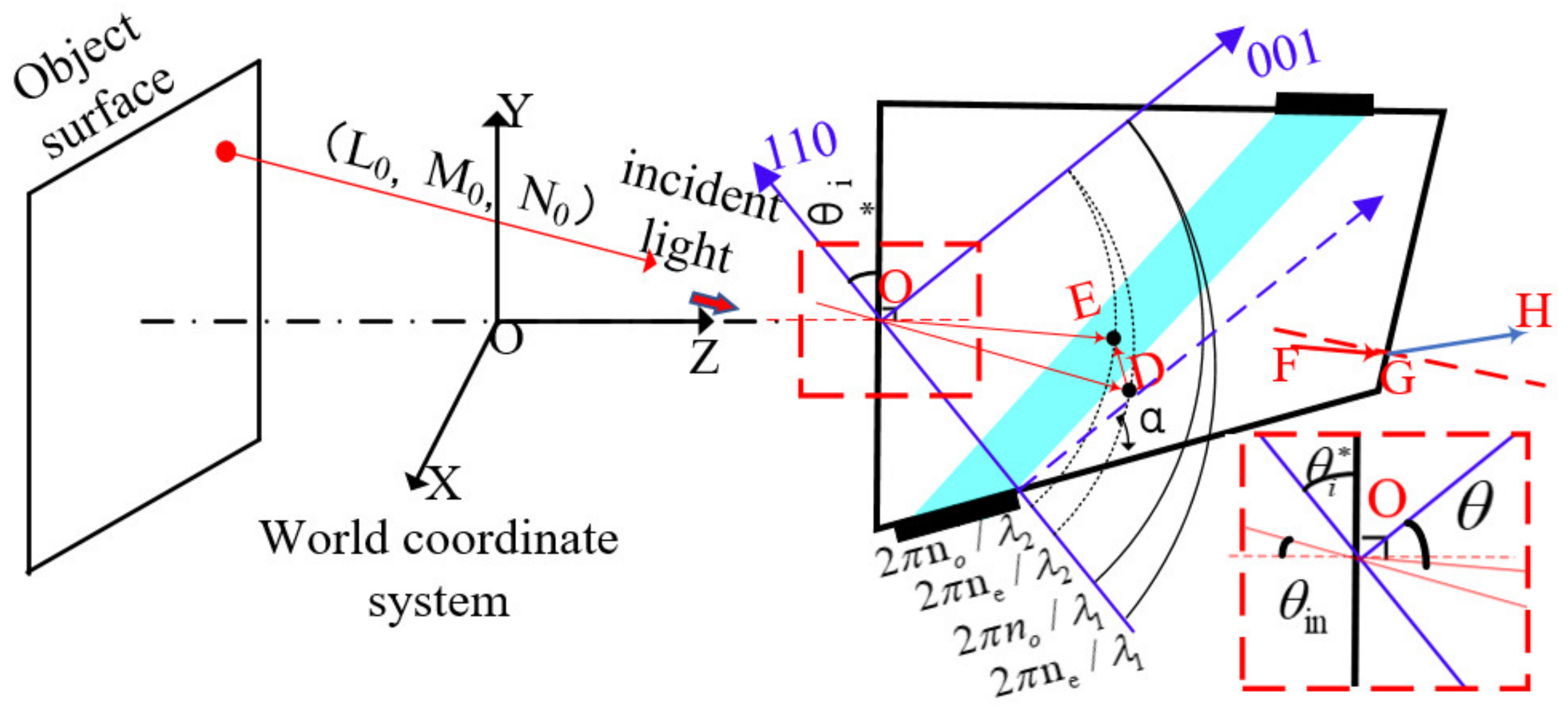
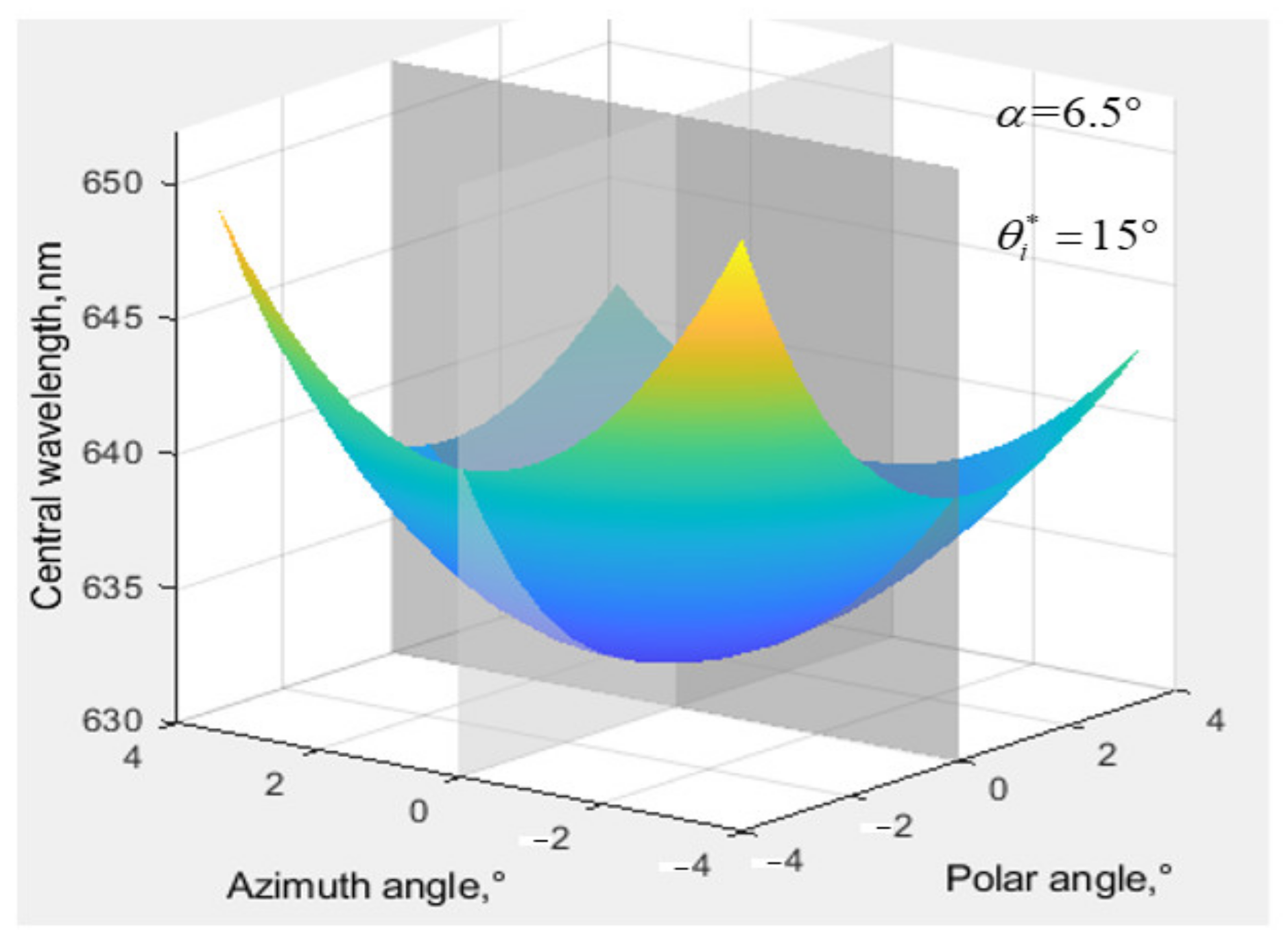

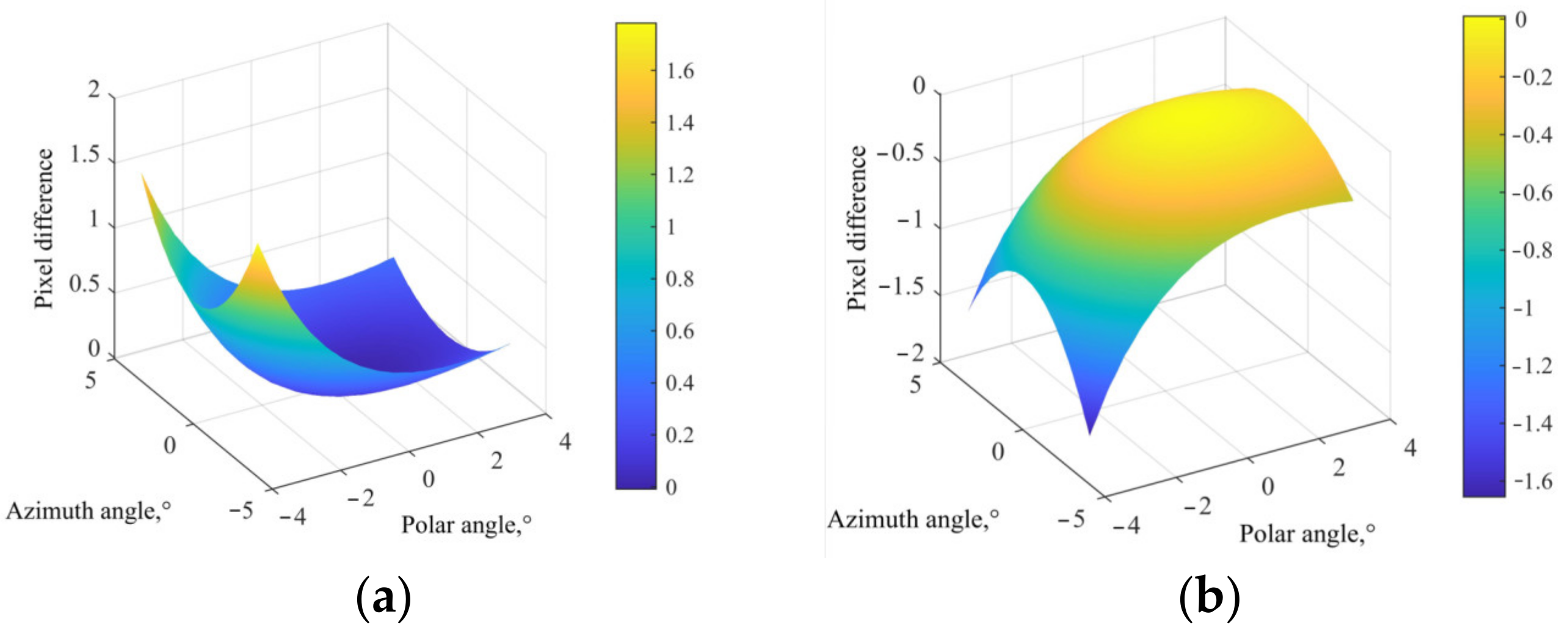

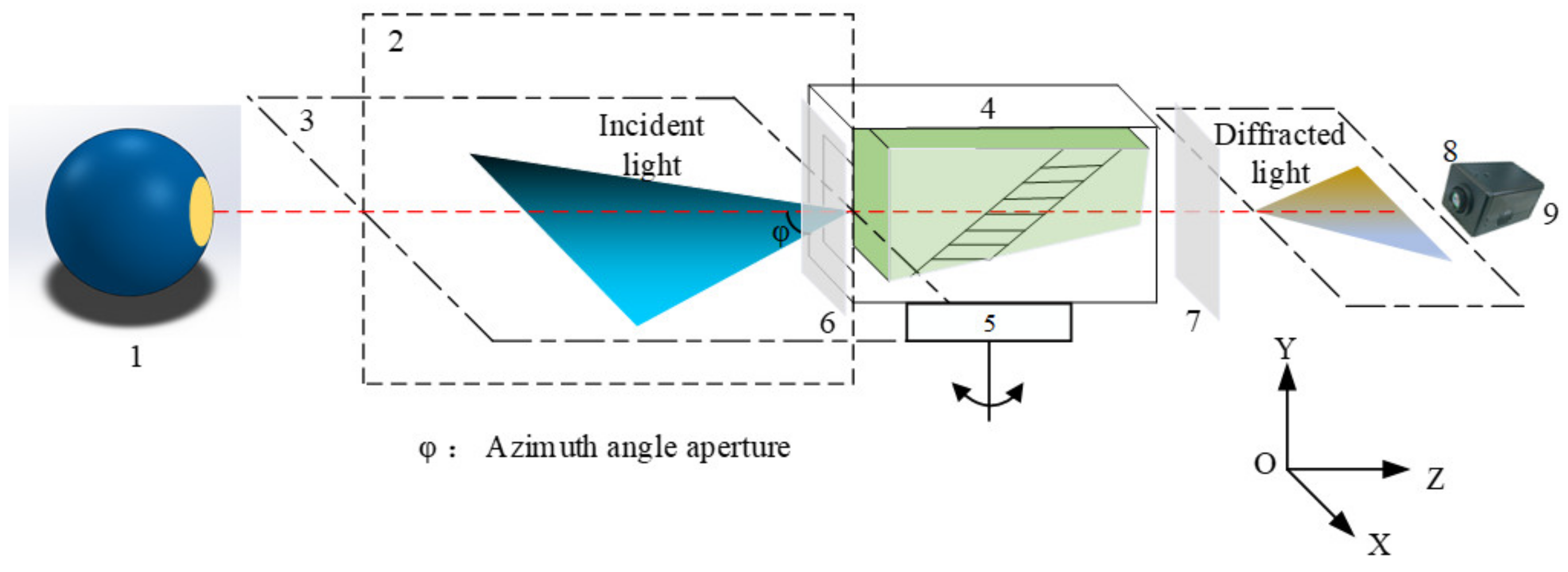




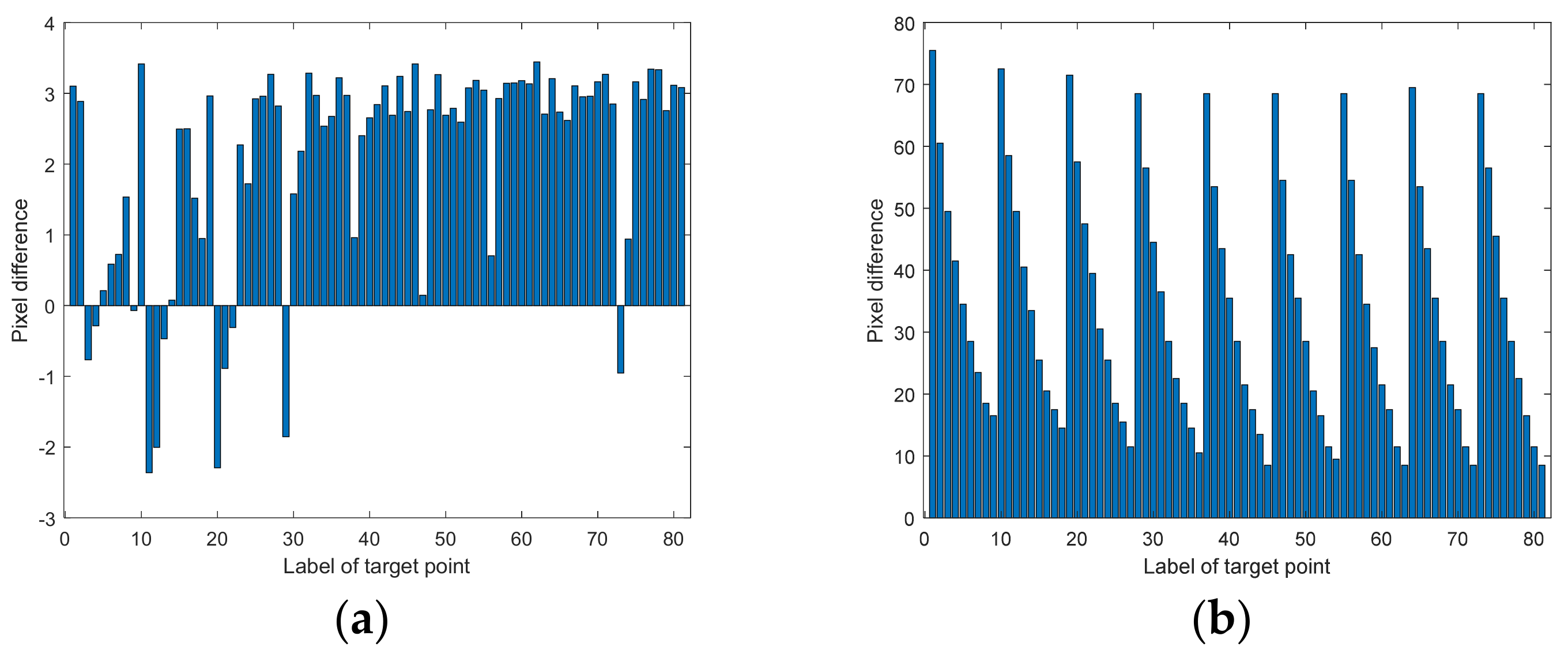

Publisher’s Note: MDPI stays neutral with regard to jurisdictional claims in published maps and institutional affiliations. |
© 2022 by the authors. Licensee MDPI, Basel, Switzerland. This article is an open access article distributed under the terms and conditions of the Creative Commons Attribution (CC BY) license (https://creativecommons.org/licenses/by/4.0/).
Share and Cite
Yu, K.; Zhao, H. Analysis on the Influence of Incident Light Angle on the Spatial Aberrations of Acousto-Optical Tunable Filter Imaging. Materials 2022, 15, 4464. https://doi.org/10.3390/ma15134464
Yu K, Zhao H. Analysis on the Influence of Incident Light Angle on the Spatial Aberrations of Acousto-Optical Tunable Filter Imaging. Materials. 2022; 15(13):4464. https://doi.org/10.3390/ma15134464
Chicago/Turabian StyleYu, Kai, and Huijie Zhao. 2022. "Analysis on the Influence of Incident Light Angle on the Spatial Aberrations of Acousto-Optical Tunable Filter Imaging" Materials 15, no. 13: 4464. https://doi.org/10.3390/ma15134464
APA StyleYu, K., & Zhao, H. (2022). Analysis on the Influence of Incident Light Angle on the Spatial Aberrations of Acousto-Optical Tunable Filter Imaging. Materials, 15(13), 4464. https://doi.org/10.3390/ma15134464





